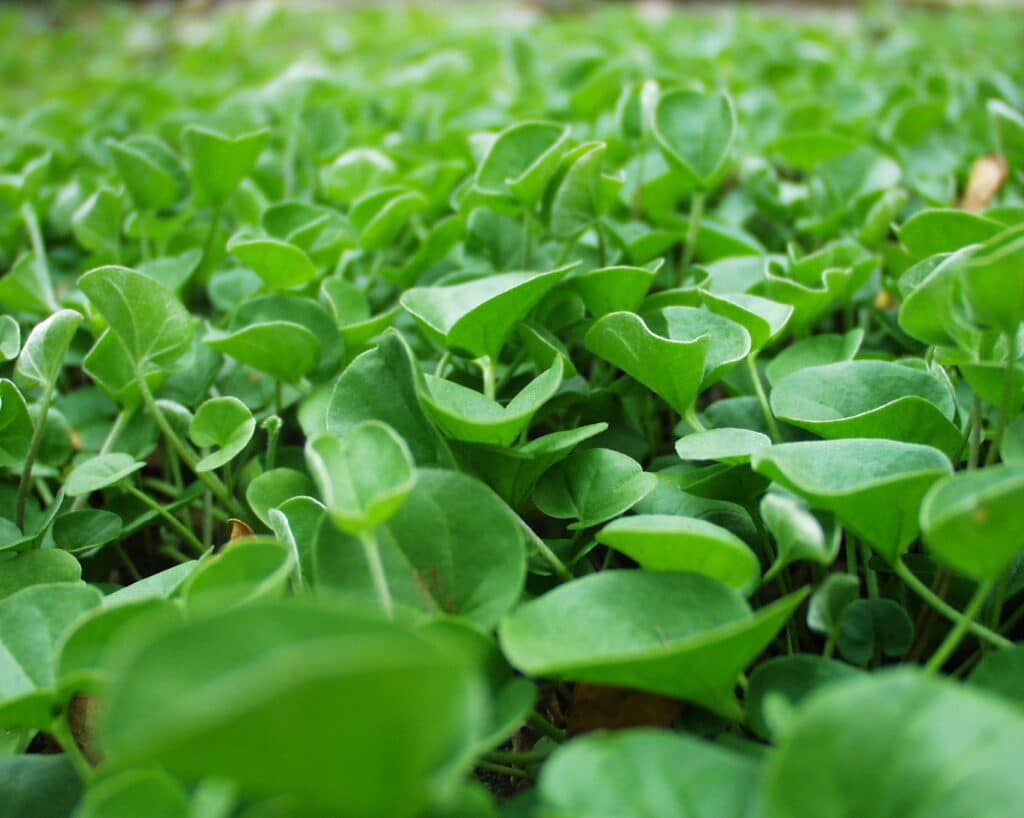Menu
Opening Hours: 9am-5:30pm, Every day except closed on Christmas Day and Boxing Day.
Opening Hours: 9am-5:30pm, Every day except closed on Christmas Day and Boxing Day.

Dichondra repens is a low growing, creeping perennial that spreads by underground runners. The leaves are kidneyshaped and dark green in colour. The overall appearance is that of a flat cover with a neat velvety appearance throughout the year, and needs no mowing. Dichondra is not recommended for sunny positions, but in shady or part shade position it will provide a good low maintenance lawn substitute.
Preparation and Planting
Ideally spring or autumn planting is most rewarding, but dichondra may be planted at any time of the year. Prepare soil with more organic matter than you would for a grass lawn. Level the surface well to avoid low places that will collect or hold water. The addition of several inches of good topsoil containing a high percentage of organic material assists in establishing a deep-rooted vigorous growing turf. Where the soil is ironstone gravel or clay, the above preparation also applies.
Area
Broadcast the seed then rake the soil over and firm down. Seed should not be more than 1cm deep. 500g of seed should cover approximately 50 square metres. It may be sown more sparingly, taking a little longer to establish. At planting, add a double handful of blood and bone per square metre.
Establishment
Keep Dichondra well watered from the time the seed is sown until the plants are well established. The seeds germinate in one or two weeks, the first two leaves being opposite and sharp-pointed. After the plant has developed twelve leaves, runners begin and the plant spreads rapidly. Weeding at this time is advisable to aid plant growth and reduce later labour. Seed will grow into a beautiful lawn in 5 months. It can grow in sun with sufficient water but a part shade position is recommended. While it can make a casual cover among native shrubs, etc, it will not remain an immaculate lawn without proper aftercare.
Care of Dichondra
When Dichondra has fully covered the planting area, it requires similar watering to a grass lawn during summer months. However, do not overwater during spring or autumn – better to let it become dry – as overwatering at these times can encourage fungal disease which causes browning off. Dichondra reseeds itself in early summer. Some leaves at this time turn yellow and cover the seeds, which germinate freely. To keep the lawn a healthy green colour, fertiliser should be applied two or three times a year depending on the structure and quality of the soil. A good organic fertiliser, low in nitrogen content and capable of
improving the friability and soil structure is recommended. Dichondra thrives on a wellconditioned soil, high in humus content.
No Mowing
Though Dichondra requires no mowing, in the early stages the turf can be 8–10cm deep. As root development takes place the stems become shorter and the turf more dense until it forms a tight, firm cover.
We love your feedback, please review us on Google

“Zanthorrea Nursery has been an accredited nursery and garden centre for many years, and is active in supporting Greenlife Industry Australia and the Nursery and Garden Industry of WA”
